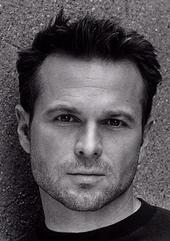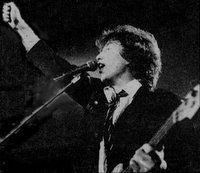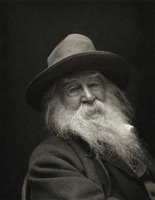 Angus McBean born 8 June 1904 (d. 1990)
Angus McBean born 8 June 1904 (d. 1990)Angus McBean was a Welsh photographer, associated with surrealism.
McBean was born in Newbridge, Monmouthshire, the son of a coal mine surveyor. He bought his first camera and tripod as World War I was ending. Fascinated by the apparently magical properties of photography, he wanted to be able to take pictures of people and sold a gold watch left to him by his grandfather to raise the five pounds necessary for the equipment.
In 1925, after his father's early death, McBean moved with his mother and younger sister to Acton, London. He worked for Liberty's department store in the antiques department learning restoration, while his personal life was spent in photography, mask-making and watching plays in the West End theatre. In 1932 he left Liberty and grew his distinctive beard to symbolise the fact that he would never be a wage-slave again. He then worked as a maker of theatrical props, including a commission of medieval scenery for John Gielgud's 1933 production of Richard of Bordeaux.
McBean's masks became a talking point in social columns, and were much admired by the leading Bond Street photographer Hugh Cecil. Cecil offered McBean an assistant's post at his Mayfair studio, and having learnt the secrets of Cecil's softer style and after using the studio at night, McBean set up his own studio 18 months later in a basement in Belgrave Road, Victoria, London.
 The artist McBean as he was still known as a mask maker, gained a commission in 1936 from Ivor Novello for masks for his play The Happy Hypocrite. Novello was so impressed with McBean's romantic photographs that he commissioned him to take a set of production photographs as well, including young actress Vivien Leigh. The results, taken on stage with McBean's idiosyncratic lighting, instantly replaced the set already made by the long-established but stolid Stage Photo Company. McBean had a new career and a photographic leading lady: he was to photograph Vivien Leigh on stage and in the studio for almost every performance she gave until her death thirty years later.
The artist McBean as he was still known as a mask maker, gained a commission in 1936 from Ivor Novello for masks for his play The Happy Hypocrite. Novello was so impressed with McBean's romantic photographs that he commissioned him to take a set of production photographs as well, including young actress Vivien Leigh. The results, taken on stage with McBean's idiosyncratic lighting, instantly replaced the set already made by the long-established but stolid Stage Photo Company. McBean had a new career and a photographic leading lady: he was to photograph Vivien Leigh on stage and in the studio for almost every performance she gave until her death thirty years later. McBean resultantly became one of the most significant portrait photographers of the 20th century, and was known as a photographer of celebrities. In the Spring of 1942 his career was temporarily ruined when he was arrested in Bath for committing homosexual acts. He was sentenced to four years in prison and was released in the autumn of 1944. After the Second World War, McBean was able to successfully resume his career.
McBean resultantly became one of the most significant portrait photographers of the 20th century, and was known as a photographer of celebrities. In the Spring of 1942 his career was temporarily ruined when he was arrested in Bath for committing homosexual acts. He was sentenced to four years in prison and was released in the autumn of 1944. After the Second World War, McBean was able to successfully resume his career.There were in effect two periods to McBean's career, his pre- and post-war phases. Pre-war he was a lot more confident in himself and experimented successfully with surrealism, indeed his work with the likes of Vivian Leigh are some of the most accessible surrealist photographic images known. Post-war he reverted to a more regular style of portraiture photography, nearly always working with the entertainment and theatre profession.
 In 1945, not sure whether he would find work again, McBean set up a new studio in a bomb-damaged building in Covent Garden. He sold his Soho camera for £35, and bought a new half-plate Kodak View monorail camera to which he attached his trusted Zeiss lenses. McBean was commissioned first by the Stratford Memorial Theatre to photograph a production of Anthony and Cleopatra, and all his former clients quickly returned. Through the late 1940s and 50s he was the official photographer at Stratford, the Royal Opera House, Sadlers Wells, Glyndebourne, the Old Vic and at all the productions of H.M. Tennent, servicing the theatrical, musical and ballet star system.
In 1945, not sure whether he would find work again, McBean set up a new studio in a bomb-damaged building in Covent Garden. He sold his Soho camera for £35, and bought a new half-plate Kodak View monorail camera to which he attached his trusted Zeiss lenses. McBean was commissioned first by the Stratford Memorial Theatre to photograph a production of Anthony and Cleopatra, and all his former clients quickly returned. Through the late 1940s and 50s he was the official photographer at Stratford, the Royal Opera House, Sadlers Wells, Glyndebourne, the Old Vic and at all the productions of H.M. Tennent, servicing the theatrical, musical and ballet star system. Magazines such as the Daily Sketch and Tatler vied to commission McBean's new series of surreal portraits.
Magazines such as the Daily Sketch and Tatler vied to commission McBean's new series of surreal portraits.Two figures have prevented McBean from gaining the full fame he deserves - the first being Cecil Beaton, whose lavish lifestyle and work for Vogue and the British Royal Family made him a huge star. And secondly that of David Bailey who though coming much later (1960s) was also close to Cecil Beaton both personally and in terms of style. Bailey is an iconic figure in the world of fashion photography just as Beaton was before him - McBean sadly did not enjoy this level of fame either in his life or after death, even though he was arguably the better technically and perhaps artistically. Additionally McBean's focus on the world of theatre (particularly London's West End) did not give him the international recognition that he probably deserved.
 McBean's later works included being the photographer for The Beatles' first album, surrealist work as well as classic photographs of individuals such as Agatha Christie, Audrey Hepburn, and Noel Coward. Both periods or his work (pre- and post-war) are now eagerly sought by collectors and his work sits in many major collections around the world.
McBean's later works included being the photographer for The Beatles' first album, surrealist work as well as classic photographs of individuals such as Agatha Christie, Audrey Hepburn, and Noel Coward. Both periods or his work (pre- and post-war) are now eagerly sought by collectors and his work sits in many major collections around the world.











































